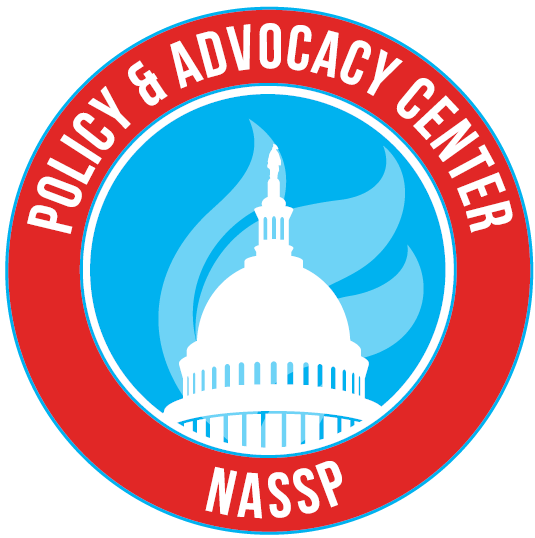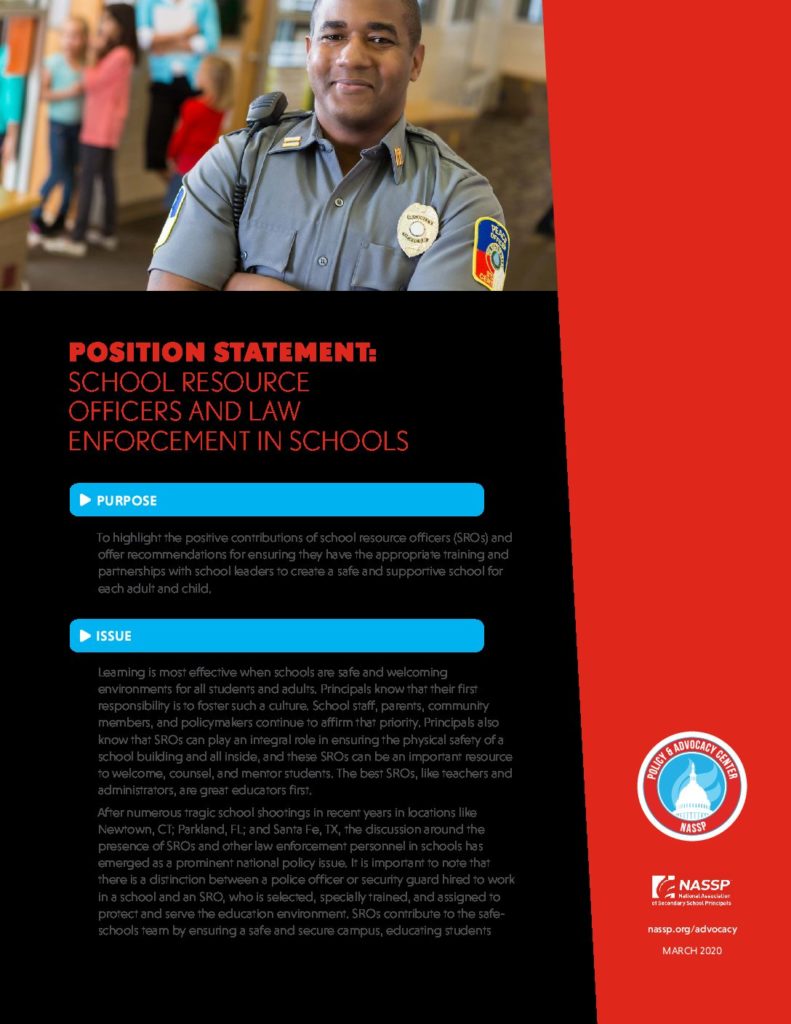To highlight the positive contributions of school resource officers (SROs) and offer recommendations for ensuring they have the appropriate training and partnerships with school leaders to create a safe and supportive school for each adult and child.
Learning is most effective when schools are safe and welcoming environments for all students and adults. Principals know that their first responsibility is to foster such a culture. School staff, parents, community members, and policymakers continue to affirm that priority. Principals also know that SROs can play an integral role in ensuring the physical safety of a school building and all inside, and these SROs can be an important resource to welcome, counsel, and mentor students. The best SROs, like teachers and administrators, are great educators first.

After numerous tragic school shootings in recent years in locations like Newtown, CT; Parkland, FL; and Santa Fe, TX, the discussion around the presence of SROs and other law enforcement personnel in schools has emerged as a prominent national policy issue. It is important to note that there is a distinction between a police officer or security guard hired to work in a school and an SRO, who is selected, specially trained, and assigned to protect and serve the education environment. SROs contribute to the safe-schools team by ensuring a safe and secure campus, educating students about law-related topics, and mentoring students as informal advisers and role models. As part of their role as informal advisers, SROs maintain open-door policies toward students and school staff, engage in mentoring sessions, and refer students or educators to social services, legal aid, community services, and public health agencies.
The 2015–16 School Survey on Crime and Safety conducted by the U.S. Department of Education reports that 22 percent of schools had a full-time SRO while 21 percent had an SRO who worked at the school part time. In addition, 68 percent of high schools had an SRO present at least once during the week compared to 59 percent of middle level schools and 30 percent of elementary schools.
With the increased presence of law enforcement personnel in schools, there is also legitimate concern about their impact on school climate, discipline, and the school-to-prison pipeline, especially with respect to disproportionate, and at times unwarranted, enforcement toward students of color. According to the Advancement Project and the Alliance for Educational Justice, black and Latino students make up over 58 percent of school-based arrests while representing only 40 percent of public school enrollment. Numerous media reports in recent years have also highlighted incidents of excessive force and exclusionary discipline for minor infractions by some law enforcement officials in schools. These incidents are unacceptable, and adequate resources must be allocated to ensure that the only law enforcement presence in a school is an SRO who has been properly vetted and trained to work in a school setting.
While the primary responsibility for the SRO is safety, regular duties can and should include service as a teacher of law-related topics such as bullying, gang violence, driving safety, underage drinking, and more. The National Association of School Resource Officers affirms that it is essential for the school district and local law enforcement agency to have a “clear and concise” Memorandum of Understanding (MOU) that defines the role of the SRO to include those of law enforcement officer, teacher, informal adviser and confidant. The MOU should also make it clear that school discipline situations are the responsibility of school administrators and not the SRO.
Guiding Principles
- The 2015 Professional Standards for Educational Leaders state that effective educational leaders promote a school community that is inclusive, caring, supportive, and promotes the academic success and well-being of each student.
- Building Ranks™: A Comprehensive Framework for Effective School Leaders presents a framework that defines the principal’s role for building culture and leading learning to foster lifelong success for each child in a rapidly changing world.
- Principals create and foster an environment in which the well-being and safety of everyone in the learning community is intentionally fostered and nurtured.
- NASSP has previously adopted position statements on safe schools and school discipline that offer policy recommendations to help schools create personalized, safe, orderly, and inviting school environments predicated on nurturing relationships and shared responsibility.
- Specially trained SROs serve as educators, mentors, and support figures for students while maintaining the physical security of the building—playing a vital role in ensuring that schools are safe and welcoming places where all students can learn.
- Principals, in cooperation with SROs, should establish relationships with essential stakeholders in the community to provide first-response teams to ensure the safety of everyone in the school.
- Trusting relationships in school are the most effective means of ensuring school safety.
Recommendations
Recommendations for Federal and State Policymakers
- Assist districts and schools by increasing funding for the recruiting, hiring, and training of SROs, recognizing that they are an integral component to a safe school environment.
- Enact policies requiring all law enforcement officials who work in schools to undergo extensive training that adequately equips them to work in a school setting and specifically with children, adolescents, and those with special needs.
- Adequately fund and support evidence-based, proven SRO training programs and ensure that all current and aspiring SROs have access to them. Training for SROs should be an ongoing process, with ample opportunities for professional development and continued learning.
- Remove barriers between education and local health service agencies and encourage local communities to focus on schools as the hub for delivery of mental and other health and social services.
- Do not enact policies that would allow administrators, teachers, or anyone other than specially trained SROs to carry firearms in school.
- Give states and local communities the ability to combine federal and state funding from separate agencies to address mental health and school safety issues at the local level.
Recommendations for District Leaders
- Develop responsive systems to support school safety in partnership with all stakeholders, including SROs. This includes a uniform code of conduct that contains clear policies regarding bullying and harassment and meets all federal, state, and board requirements pertaining to investigations, recording, and reporting.
- Ensure that SROs are professionally trained to work in a school setting, with students, and with children with special needs. Security officials who are not active duty law enforcement officers and law enforcement officers who have not completed adequate training to work in school settings are not acceptable substitutes for specially trained SROs.
- Implement minimum training requirements for SROs and ensure that the training includes the proactive and responsive systems delineated above and adequately prepares them to work specifically with children, adolescents, and special-needs students to ensure a safe, orderly, and inviting school environment. Other suggested elements of effective SRO training programs include cultural diversity and implicit bias awareness, school and personal liability issues, mediation and conflict resolution including de-escalation techniques, disaster and emergency response, and student behavioral dynamics including current child and adolescent development and brain research.
- Ensure that specially trained SROs are the only individuals who are permitted to carry or access firearms on school grounds.
- Ensure that principals are directly involved in the interview, hiring, and ongoing professional evaluation process for SROs and have the opportunity for meaningingful input about candidates for open positions to ensure that they are a good fit for the school’s culture and climate.
- Maintain ongoing development for all staff, including SROs, regarding school safety, bullying, vaping/tobacco use, and related mental health issues.
- Provide training to school leaders that outlines their discipline management responsibility versus the law enforcement responsibilities of a SRO as well as the legal boundaries for SRO action and investigation in schools.
- Use emergency preparedness plans that follow the National Incident Management System for Schools developed by the U.S. Department of Homeland Security.
- Work with school leaders and their SROs to establish curricula for grades K–12 that address violence prevention and bullying, including electronic aggression.
- Collaborate with school leaders, parents, SROs, other local law enforcement agencies, public and private social service agencies, and other agencies to develop programs and services to foster caring schools and communities.
Recommendations for School Leaders
- Ensure that discipline issues in schools are the responsibility of the principal, assistant principals, or other administrators as designated by the principal and should not be handled by SROs.
- Develop a MOU with local law enforcement that clearly defines the role of SROs to include those of law enforcement officer, teacher, and informal adviser. The MOU should make it clear that school discipline situations are the responsibility of administrators and not the SRO.
- Develop proactive systems to address school safety that include all stakeholders, including SROs. This includes creating a personalized, safe, orderly, and inviting school environment predicated on nurturing relationships and shared responsibility.
- Ensure that physical restraint and seclusion tactics are avoided to the greatest extent possible by SROs and all school staff.
- Complete the Introduction to the Incident Command System for Schools (IS-100.SCa for Schools) course, which was designed by the U.S. Department of Homeland Security in collaboration with the U.S. Department of Education, available through the Federal Emergency Management Agency’s Emergency Management Institute.
- Regularly administer a schoolwide culture survey of students, parents, and school personnel, including SROs. The climate survey should measure the degree to which the well-being and safety of everyone in the learning community is intentionally fostered and nurtured, including relationships, collaborative leadership, ethics, equity, wellness, and communication—factors NASSP believes contribute to a supportive environment and increased student achievement.
- Collaborate with parents, SROs, other local law enforcement agencies, public and private social service agencies, and other agencies to develop programs and services to foster caring schools and communities.
- Partner with all stakeholders, including the news media, to ensure transparency and responsible dissemination of information regarding school safety and the role of the SRO in the building.
Resources
Advancement Project (2018). We came to learn: A call to action for police-free schools. Retrieved from http://advancementproject.org/wp-content/uploads/WCTLweb/docs/We-Came-to-Learn-9-13-18.pdf?reload=1536822360635
Alonzo Anderson, K. (2018). Policing and middle school: An evaluation of a statewide school resource officer policy. Middle Grades Review 4(2). Retrieved from: https://files.eric.ed.gov/fulltext/EJ1192862.pdf
Canady, Mo (2018). NASRO standards and best practices for school resource officer programs. Retrieved from: https://nasro.org/cms/wp-content/uploads/2013/11/NASRO-Standards-and-Best-Practices.pdf
Centers for Disease Control and Prevention (2017). Youth risk behavior surveillance—United States, 2017. Retrieved from https://www.cdc.gov/healthyyouth/data/yrbs/pdf/2017/ss6708.pdf
Cowan, K. C., Vaillancourt, K., Rossen, E., & Pollitt, K. (2013). A framework for safe and successful schools. Retrieved from https://www.nasponline.org/resources-and-publications/resources-and-podcasts/school-climate-safety-and-crisis/systems-level-prevention/a-framework-for-safe-and-successful-schools
Congressional Research Service (2018). School resource officers: Issues for Congress. Retrieved from: https://www.everycrsreport.com/files/20180705_R45251_db5492370a04c7e3b39f27ce52416d229a0ac17d.pdf
Leadership for Educational Equity. Emerging models for police presence in schools. Retrieved from: https://educationalequity.org/sites/default/files/documents/emerging_models_for_school_resource_officers_final.pdf
National Association of School Resource Officers (NASRO) (2012). To protect & educate: The school resource officer and the prevention of violence in schools. Retrieved from: https://nasro.org/cms/wp-content/uploads/2013/11/NASRO-To-Protect-and-Educate-nosecurity.pdf
National Association of School Resource Officers (NASRO) (2015). NASRO position statement on police involvement in student discipline. Retrieved from: https://nasro.org/news/press-releases/nasro-position-statement-police-involvement-student-discipline/
National Association of School Resource Officers (NASRO) (2014). Basic 40-hour school resource officer course outline and objectives. Retrieved from: https://nasro.org/cms/wp-content/uploads/2014/04/NASRO-Basic-Course-Description-and-Outline.pdf
National Policy Board for Educational Administration (NPBEA) (2015). Professional standards for educational leaders 2015. Retrieved from: https://ccsso.org/sites/default/files/2017-10/ProfessionalStandardsforEducationalLeaders2015forNPBEAFINAL.pdf
National School Safety and Security Services (2019). Policing the Schools: Strategies for Effective Principal – Police Partnerships. Retrieved from: https://www.schoolsecurity.org/school-safety-and-communications-services/policing-the-schools-strategies-for-effective-principal-police-partnerships/
Stern, Alexis, and Petrosino, Anthony. What do we know about the effects of school-based law enforcement on school safety. Retrieved from: https://www.wested.org/wp-content/uploads/2018/04/JPRC-Police-Schools-Brief.pdf
U.S. Department of Education National Center for Education Statistics (2019). Crime, Violence, Discipline, and Safety in U.S. Public Schools. Retrieved from: https://nces.ed.gov/pubs2019/2019061.pdf

